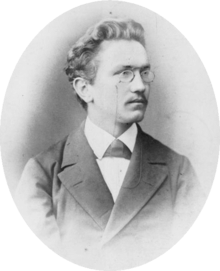Hans Huber (composer)

Hans Huber (28 June 1852 – 25 December 1921) was a composer from Switzerland who, between 1894 and 1918, composed five operas.[1] His piano concertos are slightly unusual for the form in that they have, like Brahms' second piano concerto in B-flat major, four movements (scherzos are included in addition to the usual fast, slow, and fast tempo movements).[n 1] He also wrote a set of 24 Preludes and Fugues, Op. 100, for piano four-hands in all the keys.[2]
Biography
He was born in Eppenberg-Wöschnau (Canton of Solothurn). The son of an amateur musician, Huber became a chorister and showed an early talent for the piano. In 1870 he entered Leipzig Conservatory, where his teachers included Oscar Paul. In 1877 he returned to Basel to teach, but did not obtain a post in the Conservatory there until 1889; seven years later he became director. Among his notable students were Hans Münch and Hermann Suter.
In 1889 Huber wrote an A major symphony, which was conducted in December 1889 by Friedrich Hegar, and whose full score survives.[n 2] He wrote in all nine symphonies, eight acknowledged, and several concertos, two each for violin and cello, four for piano, two of them effectively lost. During his last years he lived in Minusio in Villa Ginia. He died at Locarno.
Works
Huber's first symphony, in D minor, subtitled "Tellsinfonie" has a slight programmatic element, derived from the story of the Swiss national hero William Tell. The symphony is somewhat similar in style and formal restraint to Brahms, although there is perhaps a foreshadowing of Sibelius in some of the orchestral textures.
- Symphony n° 1 in D minor "Tellsinfonie", Op. 63 (ca.1882)
- Symphony nº 2 "Böcklin Symphony", Op. 115 (ca.1901)
- Symphony nº 3 in C major "Heroic" for Soprano and orchestra, Op. 118. (ca.1908)
- Symphony nº 4 in A "Academic" in the manner of a Concerto Grosso (1909)
- Symphony nº 5 in F major "The Fiddler of Gmund"
- Symphony nº 6 in A major Op. 134 (ca.1911)
- Symphony nº 7 in D minor "Swiss" (1922)
- Symphony nº 8 in F "Spring-symphony" (1920)
Recordings
The Swedish label Sterling has released all of Huber's symphonies, some tone poems, and the two still-extant piano concertos (nos. 1 & 3).[3][n 3] There have also been several recent recordings from Huber's substantial output of chamber works, including at least one of his cello sonatas and three CDs (as of 2012) with violin sonatas of his; one of the early recordings of Huber's music was an LP of his first piano quartet "Waldlieder", with Hans-Heinz Schneeberger at violin.
Notes
- ↑ See the forum thread linked to below, however; so far as is known only concertos 1 and 3 have come down to us intact of the piano concertos. There are also two violin concertos, one published during Huber's lifetime – his opus 40 in G minor, published 1879; another in manuscript, in D minor, based in part on one of his late violin sonatas (Appassionata)- indeed, one of its movements is an orchestration, with key changed, of the first movement of the first movement of that sonata (information on this is in the RISM database at RISM.info.)
- ↑ See the manuscript full score at Basel Library, together with information taken from Repertorium Schweizer Komponisten des 19. Jahrhunderts (ed. Arbeitsstelle Schweiz des RISM) (a source in preparation) and from Edgar Refardt's 1944 work Hans Huber. Leben und Werk eines Schweizer Musikers. There are four movements, Pastorale- Serenade- Idylle- Winzerfest, of this work, in A major, E major, C and A respectively (several RISM entries for this work, each representing a different source- full score, partial short score, etc.- have incipits for the four movements, not all of them the same ones- allowing some notion of what it would sound like if the score is performable and is taken up. From the incipits one does see that the 1889 symphony is not an early draft of his published symphony in A major (op.134) as one might have thought a possibility.
- ↑ There have also been recordings of one of Huber's works for organ, and a recording on the Organ recordings label of Mainz, both in 2001; perhaps others. The score is again available at IMSLP, in a later edition under Clarence Dickinson with the title 4 Psalm Fantasies.
References
- ↑ "Stanford Opera Site-Opera Composers:H". Retrieved 2007-01-09.
- ↑ "Gateway Bayern". Retrieved 2007-01-09.
- ↑ "Forum Thread Discussing Fate of Huber's Piano Concertos 2 and 4". Retrieved 2 May 2010.
External links
- Free scores by Hans Huber at the International Music Score Library Project Huber list of works at IMSLP
- Description of the full score of the A major Symphony of 1889 at Basel Library